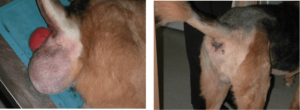Perineal hernia: Signs, diagnosis and treatment.
What is a perineal hernia?
A perineal hernia is a condition seen in dogs and cats in which the pelvic diaphragm becomes weakened. This results in displacement of pelvic and abdominal organs (rectum, prostate, bladder, or fat) into the region surrounding the anus.
The cause of this condition is not completely understood. The vast majority of cases occur in intact male dogs that are middle-aged or older. It has been hypothesized that anatomic factors, hormonal imbalances, damage to the nerves of the pelvic diaphragm, and straining due to prostate gland enlargement may contribute to the development of a perineal hernia.
Signs and diagnosis.
The first signs of a perineal hernia include straining during bowel movements, constipation and swelling around the anal region. Subsequently, the pet may have a loss of appetite. Straining to urinate may be seen if the bladder has become displaced into the hernia. If the small intestine gets trapped in the hernial sac, vomiting and depression may be seen if the bowel’s blood supply is compromised.
The diagnosis of a perineal hernia is made by digital rectal palpation performed by a veterinarian. Additional diagnostic procedures may include X-rays and ultrasound of the abdomen and hernia to make sure that the bladder is not displaced into the hernial sac. A complete blood count, chemistry profile and urine testing are performed prior to surgery to allow us to select the best anesthetic protocol for your pet.
Treatment.
Prior to surgery, the surgeon will determine if the bladder is trapped within the hernial sac. If this is the case, a catheter is placed into the bladder to relieve the build-up of urine. The perineal hernia is repaired using the internal obturator muscle flap technique. This surgical procedure creates a new pelvic diaphragm with the transposed muscle flap. Castration is always performed in conjunction with perineal hernia surgery, so that the prostate will shrink.
Below is the back end of a dog before and after surgery. Sometimes the abdomen also needs to be opened in dogs that have a severe perineal hernia, so that the rectum can be surgically fused to the abdominal wall to permanently pull it out of the hernial sac.

Results.
Overall, about 85% of the dogs that have surgery to repair a perineal hernia will have a successful outcome.


